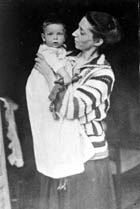by Paul Kuttner

Paul Kuttner as a baby in 1923 in Berlin with his mother Margarete Kuttner. In the First World War, Margarete Kuttner (maiden name: Fraenkel) was a nurse and later became a piano teacher. She had two children: Annemarie and Paul. According to the International Tracing Service of Arolsen (Germany), she was killed by the Nazis in the last gassing operation in Auschwitz in November 1944.
Just about the time of the 1936 summer Olympic Games in Berlin, I had the only automobile accident of my life. At the time I was 13 years old, and like most German boys my age, I loved to play soccer with neighborhood kids.
One afternoon, after I had completed my school homework, a few boys and I had our usual afternoon soccer game right in front of my house (Kaiser Allee 26, Berlin, now Bundes Allee), and as is the unfortunate habit of most children my age, they forget all about the traffic in the heat of the game, and being no exception, I too ran after the soccer ball that had been kicked too far and landed on the other side of the busy street.
Halfway across the street I was struck by a car, a large, black Mercedes.
I distinctly remember the squeal of the tires as the chauffeur applied the brakes to avoid hitting me. He did not quite succeed, but his automobile (license plate: 1A-126) had managed to reduce its speed to such an extent that its collision with me was minimal and only knocked me over, giving me no more than a few blue spots on my right leg and a bloody knee.
Still, the damage was done. I lay there, both in shock and in pain, and the chauffeur of the Mercedes jumped out of the car, asking me if I was hurt. I was and said so but miraculously managed to get back on my feet. Then the man in the back of the Mercedes-Benz got out of the car and I had a worse shock than what the accident had done to me physically.
It was Dr. Robert Ley, the Nazi leader of the Deutsche Arbeitsfront (DAF – the German Labor Front or Workers Party) to which all workers in Nazi Germany had to belong. Its headquarters was located right next to where I lived with my mother and sister. Dr. Ley was a squat little man who was known to drink heavily and as usual wore his brown SA Nazi uniform. I had seen him many times before since his office was located at Kaiser Allee 25, and he probably recognized me too. As I painfully clambered back to my feet, he seemed seriously concerned and asked me, too, if I was hurt. I confirmed his suspicions. Then he wanted to know where I lived and I pointed to the apartment building across the street.
He exchanged a few hasty words with his driver, took me by my hand and told me to take him to my parents. As we went up to my mother’s apartment, I explained to him that my parents were divorced and that I lived with my mother and sister. Finally we reached my floor, and after I rang the doorbell my mother opened the door. The shock on her face as the blood drained from it and she clutched her heart was easy to see. One of my knees bloody and me holding the hand of one of the best-known Nazi leaders. (Dr. Ley was one of those top Nazi leaders, with Hitler, Goring, Goebbels and Himmler, to commit suicide; he hanged himself with his own long underwear in his cell shortly before the Nuremberg trials started.)
Dr. Ley explained in a few words to my mother what had happened, but that I was in good shape and should be more careful in the future when playing on the street. He grabbed my stunned mother’s hand, kissed it, and said “Auf Wiedersehen, gnadige Frau,” not “Heil Hitler!”, then took the elevator down again. My mother was still so stupefied that she only pulled me into the apartment, hugged me, and then proceeded to wash my wounded knee. However, the next day she berated me for my carelessness and would not let me play outside for a week!